Welcome to our expert guide on aquarium fish acclimation! As aquarium owners, we want our fish to be healthy and happy in their new environment. Properly acclimating fish to their new home is an essential step in ensuring their well-being. The acclimation process may seem daunting, but with the right information and guidance, it can be a straightforward and successful experience.
In this section, we will introduce the topic of aquarium fish acclimation and its importance in ensuring the well-being of your fish. We will highlight the key steps involved in acclimating aquarium fish and provide an overview of the process.
Key Takeaways
- Acclimating fish is crucial for their health and happiness in their new home.
- The process involves gradually introducing fish to new water conditions to minimize stress.
- A well-prepared aquarium and patience are key to a successful acclimation process.
Understanding the Importance of Fish Acclimation
At first glance, the process of acclimating aquarium fish may seem unnecessary or even a bit tedious. However, as responsible aquarium owners, it’s important to understand the critical role that acclimation plays in ensuring the health and well-being of our fish.
When fish are transitioned from their original environment to the aquarium, they are exposed to a range of potential stressors. These may include differences in water temperature, quality, pH levels, and compatibility with other fish species. Without proper acclimation, these stressors can result in illness, trauma, or even death.
By taking the time and effort to acclimate your fish properly, you are helping to minimize the risk of stress and trauma. This leads to happier, healthier fish that are better equipped to thrive in their new environment.
Understanding the Consequences of Failing to Properly Acclimate Fish
It’s important to note the potentially severe consequences of failing to acclimate your fish properly. Fish that are not acclimated, or those that are acclimated too quickly, can experience a range of issues such as:
- Stress and trauma, which can weaken the immune system and lead to illness or disease
- Behavioral issues, such as aggression or hiding from other fish
- Difficulty adapting to their new environment, leading to a decreased chance of survival
By taking the time to properly acclimate your fish, you can avoid these potential pitfalls and help your fish to thrive in their new home.

“Proper acclimation is a critical step in ensuring the health and well-being of your aquarium fish. By taking the time to acclimate your fish properly, you are setting them up for long-term success and happiness.”
Preparing Your Aquarium for New Fish
Before introducing new fish to your aquarium, it is essential to ensure that the environment is safe and suitable for them. Here are some critical steps to take to prepare your aquarium for a successful acclimation process:
| Step | Description |
|---|---|
| Check water quality | Test your aquarium water to ensure that the pH, ammonia, nitrite, and nitrate levels are within the recommended range. Make any necessary adjustments before introducing new fish. |
| Temperature matching | Ensure that the water temperature in your aquarium is within a few degrees of the temperature of the water in the bag containing the new fish. Use a thermometer to monitor the temperature in both the aquarium and the bag to prevent any shock to the fish. |
| Compatibility with existing fish | Research the new fish species you intend to add to your aquarium and ensure that they are compatible with the existing fish. Consider factors such as size, temperament, and water parameters to avoid any potential conflicts. |
| Quarantine tank | Set up a quarantine tank for new arrivals to isolate them from the main aquarium. Observe them for any signs of illness or disease before introducing them to the main aquarium. |
Following these steps will help ensure that your aquarium is well-prepared for new fish. Remember that a healthy and safe environment is critical to the success of the acclimation process.
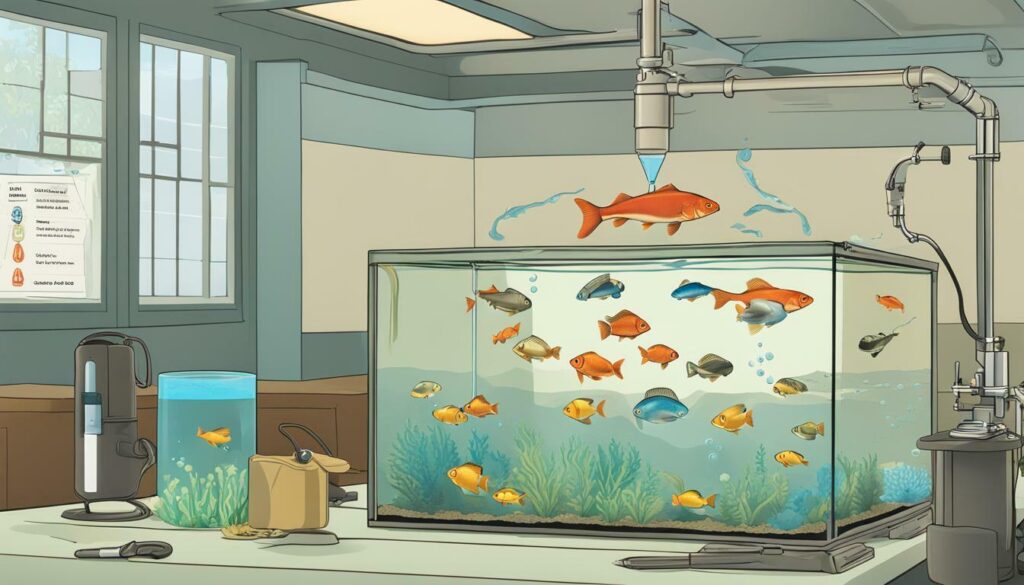
The Acclimation Process Step-by-Step
Acclimating fish into a new aquarium can be a delicate process that requires patience and attention to detail. To make the process easier, we’ve broken it down into simple steps that anyone can follow. Before starting the process, make sure that you have set up the aquarium, including adding water and heating it to the appropriate temperature. Also, ensure that the quarantine tank is clean and ready for use.
Step 1: Float the Bag
Once you’ve brought your fish home, float the bag containing the fish in the aquarium for about 15-20 minutes. This helps the water temperature in the bag to gradually adjust to the temperature of the aquarium water. To keep the bag in place, you can use a rubber band or a clip.
Step 2: Add Aquarium Water to the Bag
After the bag has floated for 15-20 minutes, open the bag and add small amounts of aquarium water every 5-10 minutes for approximately 30 minutes. This helps the fish acclimate to the water conditions such as pH and hardness. If the water in the bag is significantly different from the aquarium water, add a small amount of an aquarium water conditioner to help neutralize the water.
Step 3: Transfer the Fish to the Quarantine Tank
Using a soft net, gently transfer the fish from the bag to the quarantine tank. It’s important to avoid adding any water from the bag to the quarantine tank, as it may contain harmful bacteria or parasites. Leave the fish in the quarantine tank for about two weeks to monitor them for any signs of illness or disease.
Step 4: Gradual Introduction to the Aquarium
After two weeks, gradually introduce the fish to the main aquarium. Start by adding a small amount of aquarium water to the quarantine tank every day. Over the next week, increase the amount of aquarium water added to the quarantine tank, until the water in the quarantine tank matches the water in the main aquarium. Then, gently transfer the fish from the quarantine tank to the main aquarium using a soft net.
Step 5: Observe and Monitor the Fish
After introducing the fish to the main aquarium, closely observe and monitor their behavior for signs of stress or illness. If any issues arise, take action to resolve them immediately. It’s also important to gradually adjust the water parameters in the aquarium over time to avoid stressing the fish.

Expert Tip: Avoid adding fish to the aquarium all at once. Instead, introduce them gradually over a period of several weeks to reduce stress and ensure compatibility with existing fish.
Monitoring Your Fish During Acclimation
During the acclimation process, it’s essential to keep a close eye on your fish to ensure a smooth transition to their new environment. Remember that fish are sensitive creatures and can experience stress during this period, so it’s crucial to monitor their behavior and well-being closely.
One of the most important things to watch for is signs of distress or illness. Some common indicators of stress in fish include lethargy, loss of appetite, or abnormal swimming patterns. If you notice any of these symptoms, it’s crucial to take action immediately.
Another essential factor to consider is adjusting water parameters gradually. Sudden changes in temperature, pH, or salinity can shock the fish and cause them significant stress. Instead, make sure to adjust these parameters gradually over time, allowing the fish to acclimate slowly to the changes.
As you continue to monitor your fish during acclimation, consider adjusting your maintenance routine as well. Keep a close eye on the water quality and temperature, and perform regular water changes as needed. Remember that a healthy environment is key to keeping your fish happy and thriving.
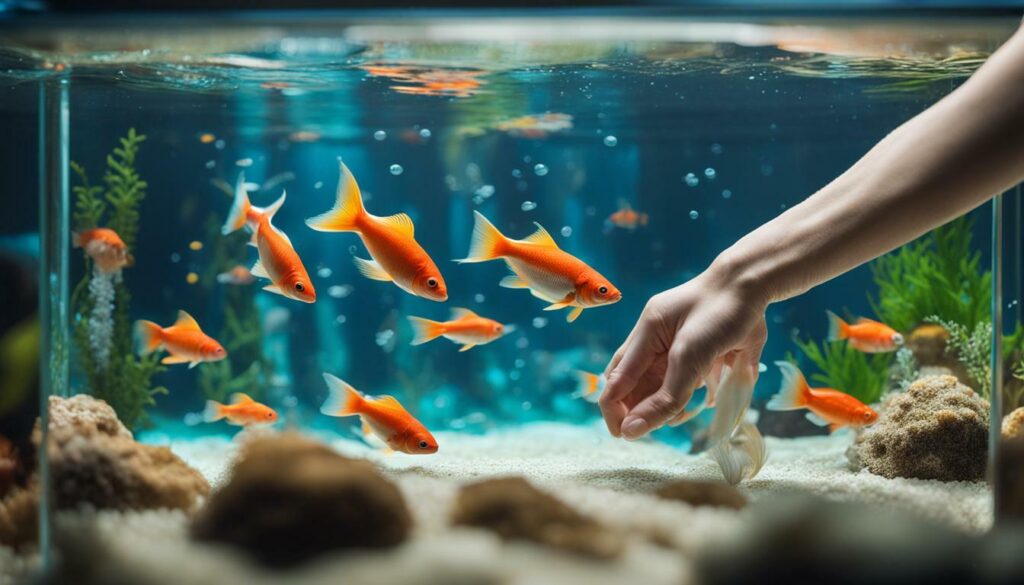
“Remember that fish are sensitive creatures and can experience stress during this period, so it’s crucial to monitor their behavior and well-being closely.”
Time Considerations for Fish Acclimation
After completing the acclimation process, it’s important to allow your fish sufficient time to adjust to their new environment. Rushing this phase can lead to stress and health problems for your fish.
It’s recommended to keep your new fish in a separate quarantine tank for one to two weeks before introducing them to a community tank. During this time, monitor the fish regularly to ensure they are healthy and acclimating well.
When transitioning the fish to a community tank, do so gradually over several days. Introduce them to their new tankmates one at a time and keep a close eye on their behavior to ensure they are not being bullied or showing signs of stress.
Remember, patience is key during the acclimation process. Allow your fish the time they need to adjust and acclimate to their new home.

Common Mistakes to Avoid in Fish Acclimation
Acclimating aquarium fish requires patience, care, and attention to detail. Unfortunately, many aquarium owners make common mistakes that can lead to stress, illness, or even death of their fish. To ensure successful acclimation, it is important to steer clear of these pitfalls.
Not Checking Water Parameters
One of the most common mistakes is not checking water parameters before introducing new fish to the aquarium. This can have severe consequences, as different species of fish have different water requirements. Failure to maintain consistent water quality can lead to stress, disease, and death. Be sure to regularly test water parameters for pH, ammonia, nitrite, and nitrate levels and make any necessary adjustments before adding new fish.
Rushing the Acclimation Process
Another mistake is rushing the acclimation process. It is important to allow sufficient time for fish to adjust to their new environment. Patience is key, as different species may require different lengths of time to acclimate. Rushing the process can cause stress, shock, and illness. Take your time and follow the proper acclimation techniques to ensure a smooth transition.
Not Quarantining New Fish
Quarantining new fish before introducing them to a community tank is crucial for preventing the spread of disease. Failure to quarantine can lead to illness and death for both new and existing fish in the tank. Use a separate tank and closely monitor new fish for any signs of illness before introducing them to the main tank.
Overfeeding
Overfeeding fish can lead to poor water quality and stress. Many aquarium owners make the mistake of feeding their fish too much, too often. Follow recommended feeding guidelines and avoid overfeeding your fish. Also, ensure that the food is appropriate for the species of fish you have in your tank.
Adding Too Many Fish at Once
Adding too many fish at once can overwhelm an aquarium’s ecosystem and lead to stress, disease, and death. It is important to add new fish gradually, starting with a small number and slowly introducing more over time. This allows the tank’s ecosystem to adjust and ensures the health and well-being of your fish.

“To ensure happy and healthy fish, it’s crucial to avoid common mistakes during the acclimation process.”
Not Monitoring Fish After Acclimation
After acclimation, it is important to closely monitor fish for any signs of stress or illness. Be on the lookout for changes in behavior, appetite, or physical appearance. Failure to monitor fish can result in missed warning signs and potentially serious health problems.
Conclusion
By avoiding these common mistakes, you can ensure a successful acclimation process for your aquarium fish. Remember to regularly check water parameters, quarantine new fish, feed appropriately, introduce new fish gradually, and monitor fish after acclimation. Following these guidelines will help promote the happiness and health of your fish for years to come.
Introducing Fish to Their New Home
After completing the acclimation process, it’s time to introduce your fish to their new home in your aquarium. This can be an exciting moment for both you and your fish, but it’s important to make sure the environment is set up to ensure a smooth transition.
Lighting: Ensure that the tank has sufficient lighting, with a timer set to simulate the natural lighting conditions of your fish’s original habitat. This helps to regulate their behavior and reduce stress.
Feeding: Offer the fish small amounts of food, gradually increasing the amount as they adjust to their new environment. Avoid overfeeding, as this can cause digestive issues and pollute the water.
Hiding places: Provide plenty of hiding places such as plants, rocks, and caves to help the fish feel secure and reduce stress. This is especially important for shy or territorial fish.
Remember to continue monitoring your fish closely during this time. Look out for any signs of distress or health issues, and adjust the environment accordingly. With patience and care, your fish will soon acclimate to their new home and thrive in their new environment.
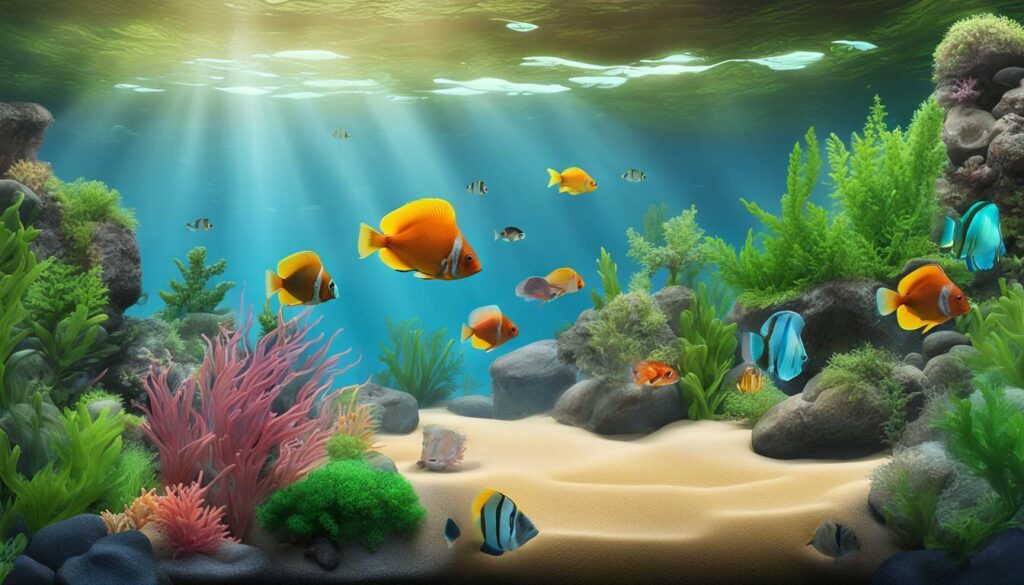
Transitioning Fish to Community Tanks
Once your new fish have successfully completed the quarantine period and have acclimated to the water conditions in the quarantine tank, it’s time to start the process of introducing them to your community tank. Before you do so, make sure that the water quality and temperature of the community tank match those of the quarantine tank.
Also, ensure that the fish in the community tank are compatible with the new arrivals. Check their temperament, size, and dietary requirements to prevent any potential conflicts and competition for food.
The best way to introduce new fish to a community tank is to do it gradually. Start with short periods of time and gradually increase the duration. This can be done by placing the quarantine tank inside the community tank and gradually opening the door or by using a clear plastic bag to float the fish for around 10-15 minutes at a time.
| Step | Description |
|---|---|
| Step 1 | Place the quarantine tank inside the community tank. |
| Step 2 | Gradually open the door of the quarantine tank. |
| Step 3 | Observe the fish for signs of stress or aggression. |
| Step 4 | Repeat the process for longer periods of time until the fish are fully integrated into the community tank. |
Be sure to monitor the fish closely during this transition period. If any signs of stress or aggression are observed, promptly remove the new arrival and try again later. In most cases, the gradual introduction process will be successful, and the new fish will happily join the community.
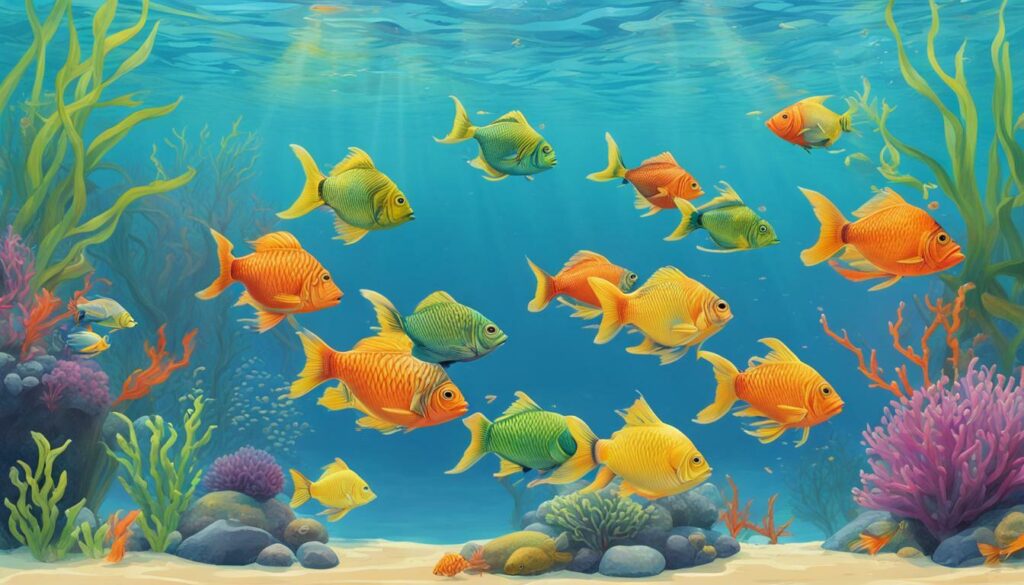
After the new arrivals are fully integrated into the community tank, continue to monitor their behavior closely. It’s important to remember that even after successful acclimation, fish may still experience stress or aggression from time to time. Be prepared to act quickly if any issues arise.
By following these tips for transitioning new fish into a community tank, you can ensure the continued health and happiness of your aquarium inhabitants.
Tips for Troubleshooting Acclimation Challenges
While acclimating your aquarium fish can be a straightforward process, challenges may arise even if you follow the best practices. Don’t worry, we’ve got your back. Here are some tips and solutions to common acclimation challenges:
Problem: Fish Refuse to Eat
If your fish refuse to eat during the acclimation process, it’s likely due to stress or shock. Here’s what you can do:
- Give your fish a few days to settle into their new environment before trying to feed them
- Try offering a different type of food than what you normally feed them
- Reduce the amount of food given to avoid overfeeding and water pollution
Problem: Signs of Distress
Stress and illness can manifest in various ways, such as lethargy, loss of color, or rapid breathing. If you notice any of these signs, take immediate action:
- Check water parameters and make sure they’re within the acceptable range
- Consider quarantining the affected fish to prevent the spread of disease
- Consult with a veterinarian who specializes in fish health
Problem: Compatibility Issues
If you’re adding new fish to an existing community tank, it’s important to research and ensure compatibility. If aggression or other issues arise, try these solutions:
- Remove the affected fish and quarantine them
- Re-arrange the tank’s decorations and hiding spots to change the fish’s territories
- Add more plants or other decorations to break up lines of sight and reduce aggression
Problem: Sudden Changes in Water Parameters
While you may need to adjust water parameters during acclimation, it’s important to do it gradually. Sudden changes can cause stress and even death. Here’s what to do:
- Test water parameters regularly and adjust them gradually to ensure consistency
- Use a water conditioner to neutralize harmful chemicals in tap water
- Consider using a drip acclimation method to slowly introduce fish to the new water conditions
By following these tips for troubleshooting acclimation challenges, you can ensure the long-term happiness and health of your aquarium fish. Now, let’s move on to the final section of our guide and discuss maintaining the well-being of your fish after acclimation.
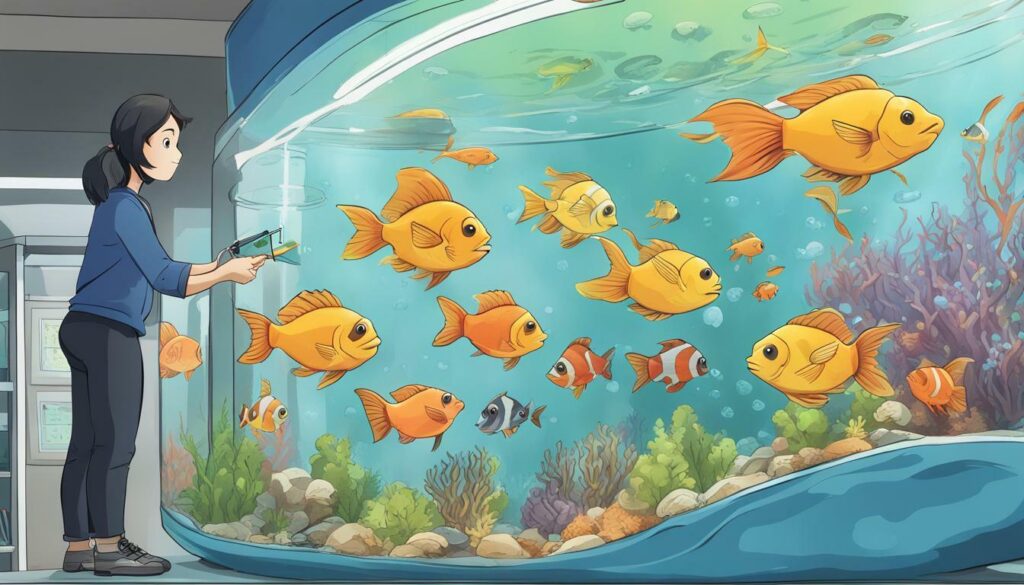
Maintaining Health and Well-being After Acclimation
After successfully acclimating your fish, it’s important to maintain their health and well-being long-term. Regular maintenance routines are key to ensuring a healthy environment for your fish to thrive in.
One of the most important aspects of post-acclimation care is monitoring water parameters. We recommend using a test kit to regularly check the levels of ammonia, nitrates, nitrites, and pH in your aquarium. If any levels are outside of the recommended range, take action to adjust them as necessary.
Another aspect of maintaining health after acclimation is feeding your fish a nutritious diet. Choose a high-quality fish food that meets their dietary needs, and avoid overfeeding, which can lead to health issues.
Regular water changes are also crucial for maintaining a healthy environment for your fish. Aim to change 10-20% of the water in your aquarium every two weeks, or more frequently if necessary. Be sure to use a dechlorinator to remove any harmful chemicals from tap water before adding it to the tank.
Finally, keep an eye on your fish’s behavior and appearance. Look out for signs of stress, illness, or aggression, and take action to address any issues that arise. With proper care and attention, your newly acclimated fish can thrive in their new home for years to come.

Conclusion
Acclimating aquarium fish is a crucial step in ensuring their health and happiness. By following the expert tips outlined in this guide, you can minimize stress and provide your fish with a smooth and successful transition to their new home. Remember to take your time, monitor your fish carefully, and maintain ongoing care to ensure their long-term well-being.
We hope that this guide has been helpful in guiding you through the acclimation process. By implementing these tips, you can create a comfortable and stress-free environment for your fish, allowing them to thrive and enjoy their new home. If you encounter any challenges or have any additional questions, don’t hesitate to consult a professional or a knowledgeable aquarium hobbyist.
Happy fishkeeping!
FAQ
Q: Why is aquarium fish acclimation important?
A: Aquarium fish acclimation is important because it helps reduce stress on the fish and increases their chances of survival. It allows them to adjust to the new water parameters and temperature gradually, minimizing shock.
Q: How long does it take to acclimate fish in an aquarium?
A: The time it takes to acclimate fish in an aquarium can vary depending on the species and the acclimation method used. Generally, it is recommended to acclimate fish for around 30 minutes to an hour.
Q: What is the best way to acclimate fish?
A: The best way to acclimate fish is by using the drip method. This involves slowly introducing water from the aquarium into the bag or container holding the fish, allowing them to adjust to the new water parameters gradually.
Q: What should I do if my fish show signs of stress during acclimation?
A: If your fish show signs of stress during acclimation, it is important to stop the acclimation process and give them time to recover. You can also try adjusting the water parameters more gradually or seek advice from a professional.
Q: Can I acclimate fish directly into a community tank?
A: It is generally recommended to acclimate fish in a separate quarantine tank before introducing them to a community tank. This helps prevent the spread of diseases and allows you to monitor the new fish closely before introducing them to established tankmates.
Q: What are some common mistakes to avoid during fish acclimation?
A: Some common mistakes to avoid during fish acclimation include acclimating fish too quickly, not monitoring water parameters, and introducing incompatible fish to the same tank. It is important to follow proper acclimation procedures and do thorough research beforehand.
Q: How often should I monitor the health of my fish after acclimation?
A: It is recommended to regularly monitor the health of your fish after acclimation. Keep an eye out for any signs of distress, changes in behavior, or physical abnormalities. Regular water parameter testing is also important to ensure optimal conditions in the aquarium.
Q: What should I do if my fish refuse to eat after acclimation?
A: If your fish refuse to eat after acclimation, it is important to give them time to adjust. Offer a variety of foods and observe their behavior. If the issue persists, consult a professional for further guidance.
Q: How often should I perform maintenance routines on my aquarium after acclimation?
A: Regular maintenance routines, such as partial water changes and cleaning filters, should be performed on a consistent schedule after acclimation. This helps maintain water quality and the overall health of the aquarium.
Q: Can I add new fish directly to an established aquarium without acclimation?
A: It is not recommended to add new fish directly to an established aquarium without acclimation. This can cause stress to both the new fish and the existing tankmates. Proper acclimation is crucial for a successful introduction.

